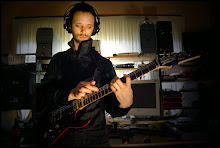AArts – Wk 4 – ‘Drumkit Recording’ – 20/03/07:
Luke and the multitalented Jake were once again my partners in the weekly recording project. The Drumkit sure is a lot of work. Once again I can’t help but feel a little adverse to the idea of commercial sound engineering when faced with laborious tasks such as this.
After wandering around with the floortom to find some kind of sweet spot, we settled on assembling the kit near and facing the window of the control room, and planned to baffle off the area to reduce the liveliness of EMU space. Then the joy of setting up a squillion mic’s, stands and cables ensued. After the hard work was dispensed with we moved on to the task of setting mic positions. There was a handy tip in the readings for this week which logically instructed the would be engineer to place one’s hand palm up near the spot most likely to be hit on a given drum. It stated that the hairs on the back of your hand should feel a rush of air emanating out from the strike zone, and the mic should be placed as close as possible to this sensation (within reason – you don’t want the drummer whacking the mic’s). It gave us a good starting point, but I doubt it would achieve any more sonic mastery than the two-finger rule explained by David in this weeks lecture.
After a long sound check (still trying to polish that turd of a bass drum to no avail) we settled on a close micing set up reminiscent of that displayed on Tuesday. SM-57's were placed over and under the snare and after repeated testing of the combined signals, there was no need for phase inversion. The condenser stereo overheads were placed about 1.5m apart and angled straight down at their respective cymbals for the first recording. This was the optimum position for me as it produced a fuller, brighter sound. The room mic was placed nice and high, so it could receive sound from directly inside the baffle area, as well as picking up reverberations from the space.
After this moderately successful attempt, we tried the X-Y axis system with the overheads for some educational comparison. This produced, to my ears, a sub standard result when compared to the previous, as there seemed to be a significant drop in the overall substance of the waveform captured.
Some before and after audio snippets are below for your perusal, so as usual make up your own mind.
Mp3's in online folder linked below:
Audio Example Folder (check the two X-Y and non X-Y examples for an interesting comparison)
Reference:
David Grice. “Recording the Drumkit”. Lecture presented at EMU space and Studio 1, 5th floor, Schultz building, University of Adelaide. 20th March 2007.





3 Comments:
That glowing drum kit is the pants.
I'll say, but I think you'd get freak'n' hot playing it long time (all dem bulbs), me so sweaty...
I rarely see a drummer fully clothed anyway, regardless of kit-luminescence. Ooh, word of the night.
I'm still laughing at the "Everyone loves a picture" thing. Gaffaw gaffaw gaffaw!
Post a Comment
<< Home